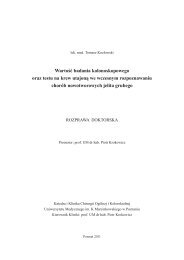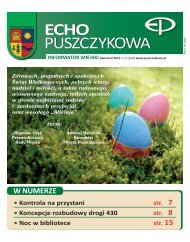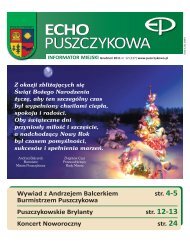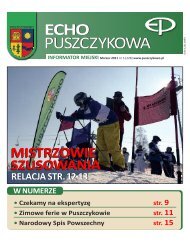MILITARY PHARMACY AND MEDICINE
MILITARY PHARMACY AND MEDICINE
MILITARY PHARMACY AND MEDICINE
Create successful ePaper yourself
Turn your PDF publications into a flip-book with our unique Google optimized e-Paper software.
© Military Pharmacy and Medicine • 2012 • 4 • 115 – 118Magdalena Cybulska at al.: Anthropological and archeological sources …about 5400 until 2200 /2100 B.C.), five — allmale — from the Bronze Age (from about2200 /2100 until half of 8 th century B.C.), six – 4male and 2 female – from Early Iron Age (fromthe second half of 8th century B.C. until the endof 7th century A.D.), and about twenty-eight — 16male and 6 female — come from the Middle Ages(from the 7th century until half of 14 th centuryA.D.). It should be noted that determining thesex of the buried person was not always possible.Larger number of skulls with signs of trepanationprobably resulted from increasing populationdensity, formation of large settlements andcities and, therefore, greater need for medical aid.Most trepanations were performed in men. Itwas probably related to the fact that men wereat greater risk of head traumas and injuries, e.g.during hunting, battles and fights. It is consistentwith earlier epidemiological studies showingthat, both in the Middle Ages and nowadays,men are more prone to traumatic injuries. Inthe medieval times, the number of skull injuriesin men increased almost threefold.However,this relationship was not observed in women[22]. Skulls with trepanation holes were mostoften adult, although there were few belongingto young people or the elderly. Naturally, oneshould emphasize that the ages of these individualswere determined at the time of death. If theorifice is not obliterated, one may conclude thatthe person died during the procedure and the ageat the time of death is consistent with the age, atwhich trepanation was performed. However, ifthe opening is well obliterated, it is then difficultto estimate the age range, within which trepanationwas performed. Obliteration may be a proofof patient’s survival for several months or years.There are no children’s’ skulls bearing signs oftrepanation in the materials obtained in ourcountry. Possibly, this kind of procedure wasrarely performed in young individuals. Fragilechildren’s skeletons are quickly decomposed,which is the reason why the signs of trepanationare poorly visible. It is also likely that childrendid not suffer from conditions, which couldbe considered indications for such procedures.Possibly, children less often fell victims to severehead injuries in the past. However, such procedureswere performed during the Greek-Romantimes. In this region of the world, doctors werefamiliar with the works of Hippocrates andhttp://military.isl-journals.comGalen, who mentioned trepanation as one oftherapeutic methods [23].There are also very few trepanation skulls fromthe Bronze Age and Early Iron Age found inPoland. It could be related to the custom of bodyburning (cremated human remains are placedin an urn or directly in the grave), as it is muchmore difficult to recognize changes related to diseaseor surgical procedures in burnt remains.Trepanation was most often performed in thearea of parietal (more often on the left side) andfrontal bones, rarely on the occiput. Trepanationholes rarely involved more than one bone. In thestudied cases, holes were located at the top of thehead or at a lateral surface of the skull – in suchcases they involved the squama of temporal boneand occiput. Trepanation holes rarely overlappedwith cranial sutures, although there were few suchcases collected in Poland. Surgeons probably distinguishedbetween cranial sutures and bone fractures.Sizes of trepanation holes vary. Some areextensive (5-6 cm in diameter), while other onesare small (less than 1 cm). Trepanned skulls collectedfrom Poland area most often contain onlyone hole. In two cases from neolithic times andtwo cases from the Middle Ages, we were dealingwith two holes. No skulls with multiple trepanationholes were obtained from Polish region. Thesize and positioning of trepanation hole was certainlyrelated to the location and extent of injury(in posttraumatic trepanations), but it could berelated to the site, where the patient experiencedpain, treatment method and applied tools.In Poland, since the neolithic period until MiddleAges, trepanations were performed throughscraping and cutting. The first method was safer,as it was associated with lower risk of brain damage.Tools with a cutting edge were used, butonly for scraping the bone. Tool motion couldbe performed in a vertical or horizontal motion.Sometimes, both methods were used togetherand both neolithic and medieval skulls bearsigns of such procedures. Literature emphasizesthat the cutting method was used for acquisitionof bone talismans (from the dead), althoughthere are skulls found in Poland with trepanationholes indicating that this method was alsoused for therapeutic purposes, particularly inthe medieval period and at the turn of MiddleAges and the modern era.115
















